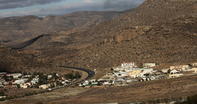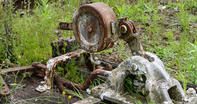Construction of the Line
In the nineteenth century, the Cape Copper Company applied for an extension of the narrow-gauge railway to O’okiep. This was granted in 1871 and work began on the Anenous Pass section (which climbs 1330 feet in only seven and a half miles).

The railway finally reached O’okiep in 1876. The total cost of the railway and its complementary jetty at Port Nolloth was £170 000. This is a bargain when you consider that an estimated £500 000 of lower grade ore was stockpiled at the mines, just waiting for a more cost-effective transportation method. At first, teams of mules were used to pull the railroad trucks along the path, as was stipulated in the various government acts that authorised the construction of the line.
However, Hall wanted to try a steam engine. Two of these locomotives arrived in 1871 and were put to use over a section of the line, but they required a lot of water (which was always in short supply) and often broke down.
So, the trusty mules were put back into service and continued to pull coaches along the track, as follows: freight trucks were grouped into threes and pulled by six mules in single file, while passenger ‘specials’ were pulled by three mules. This was doubled for the uphill section of the Anenous Pass and the mule teams were changed every 28 miles.
Wonder and Terror

The only notable exception to this system was on the down run, when the cars were tied together at the top of the Pass and allowed to coast all the way down to Port Nolloth, with a brakeman checking the speed. If that sounds hairy, consider that when going up the pass, a man sat at the front of the locomotive scooping sand onto the tracks to prevent the wheels from slipping.
Contemporary passenger accounts of trips up the pass are full of wonder and terror in equal measures. From 1878, the light rails were replaced by heavier rails, in anticipation of the re-introduction of steam locomotives. This took place in 1886, when special condenser-type engines were brought in.
These didn’t work too well in the high temperatures, however, and were soon replaced with Kitson ‘mountain type’ locomotives. This shortened the travelling time from two days (during which people would overnight at the Klipfontein Hotel, at the top of the Anenous Pass) to an eight-hour trip that could be completed in a single day. By 1896, steam traction was used along the entire line, although the mule teams were still maintained for times of drought.
A Huge Success

All in all, the railway line was a huge success and the Namaqualand copper fields were finally placed on a firm footing. However, it wasn’t all sunshine and light. The line, as you’ll remember was owned by the Cape Copper Company and, although they were legally obligated to act in the interests of developing the country, they often made things very difficult for members of the public and their rival at Concordia Mine.
Discriminatory tariffs were charged and numerous complaints were made. However, the government was reluctant to act against the mighty Cape Copper Company and, after 10 years of operation, they declined to exercise their option to purchase the line at the cost price of construction, thus forfeiting the right entirely.
The Cape Copper Company was then pretty much free to do as they pleased with their line. But progress is inevitable, even in the wilds of Namaqualand. In 1927, the South African Railways line from Cape Town reached Bitterfontein (a couple of hundred kilometres to the south). Now, the mines found it more effective to transport the ore by road to the new railhead, thus effectively ending the life of the Port Nolloth railway.
It remained in the possession of the O’okiep Copper Company (successors of the Cape Copper Company) and continued to operate until 1942. The line was then scrapped and sold in 1944. Its remnants can still be seen in the pylons that carry the power lines over the mountains.
By David Fleminger